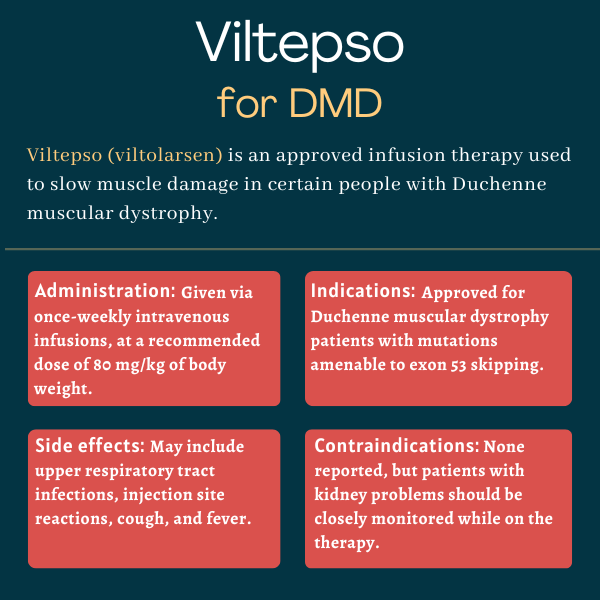Viltepso (viltolarsen) for Duchenne muscular dystrophy
Last updated April 16, 2024, by Marta Figueiredo, PhD

What is Viltepso for Duchenne muscular dystrophy?
Viltepso (viltolarsen) is an exon-skipping therapy approved for people with Duchenne muscular dystrophy (DMD) who carry mutations amenable to exon 53 skipping.
Administered via an intravenous, or into-the-vein, infusion, it is intended to slow disease progression and potentially improve motor function in eligible patients.
The medication is conditionally approved in the U.S. based on early evidence that it can significantly raise levels of dystrophin, the protein that is missing in Duchenne patients. Additional clinical trial data confirming it can slow, or even reverse, disease progression will be needed for a full approval.
The therapy initially was discovered by the Japanese pharmaceutical Nippon Shinyaku and the National Center of Neurology and Psychiatry in Japan, and later also was developed by NS Pharma, a U.S. subsidiary of Nippon Shinyaku.
Therapy snapshot
| Brand name: | Viltepso |
| Chemical name: | Viltolarsen |
| Usage: | Treatment of DMD patients with mutations amenable to exon 53 skipping; intended to slow disease progression and improve motor function |
| Administration: | Intravenous infusion |
How does Viltepso work?
Duchenne muscular dystrophy is caused by mutations in the DMD gene, which provides the instructions to make dystrophin, a protein that is key to protecting muscle cells against contraction-induced damage.
These mutations result in virtually no production of functional dystrophin, ultimately leading to progressive muscle weakness and wasting. Most of these genetic errors result in the loss of one or more exons, or the protein-coding sections of genes that work like pieces of a puzzle to make a full-length protein.
This means that when the information in DNA is translated into an intermediate molecule that guides protein production, called messenger RNA (mRNA), the remaining exons do not fit together properly and the resulting protein does not work as it should.
As an exon-skipping therapy, Viltepso can make the cells’ protein-making machinery skip over certain exons, so that the remaining exons in the mRNA molecule fit together to make a shorter but working dystrophin protein.
The therapy, which belongs to a class of molecules called antisense oligonucleotides (ASOs), specifically masks DMD’s exon 53 to increase the levels of functional dystrophin. By doing so, Viltepso is expected to slow muscle degeneration for the 8%-10% of DMD patients carrying mutations that are amenable to exon 53 skipping.
Who can use Viltepso?
Viltepso was granted conditional approval by the U.S. Food and Drug Administration in August 2020 to treat people with Duchenne muscular dystrophy who have a DMD mutation that is amenable to exon 53 skipping.
Conditional, or accelerated, approval means that the therapy can be marketed based on less comprehensive safety and efficacy data than normally required, and that additional clinical trial results confirming its benefits are needed for full approval.
The regulatory decision made Viltepso the second exon 53-skipping therapy to be approved for eligible DMD patients in the U.S., following Vyondys 53 (golodirsen). However, Viltepso was the first to show an increase in dystrophin levels in children as young as age 4.
Viltepso also is approved in Japan for the same indication. The therapy currently is not available in Europe.
Who should not use Viltepso?
Viltepso’s prescribing information lists no contraindications. However, patients with known kidney function issues should be closely monitored during treatment.
How is Viltepso administered?
Viltepso is administered via weekly intravenous infusions lasting 60 minutes each, which can be given by a healthcare provider at the home or at a treatment center.
The medication is available in single-dose vials containing 5 mL of a clear and colorless solution with 250 mg of the medication (50 mg/mL). It is administered at a recommended dose of 80 mg per kilogram of body weight.
Viltepso should not be mixed with other medications or infused simultaneously with other therapies through the same intravenous access line. In case a dose is missed, the therapy should be administered as soon as possible.
Patients with kidney impairment should be closely monitored while on Viltepso.

Viltepso in clinical trials
Conditional approval of Viltepso was mainly supported by data from a Phase 2 clinical trial (NCT02740972) conducted in North America, and a Japan-based Phase 1/2 study (Japic CTI-163291). Full approval is pending results of a confirmatory Phase 3 trial called RACER53 (NCT04060199).
North America trial
The Phase 2 trial, conducted in the U.S. and Canada, enrolled 16 boys (ages 4 to 9) with DMD and a confirmed mutation amenable to exon 53 skipping. All were able to walk independently and were on a stable dose of corticosteroids, a standard DMD treatment, for at least three months.
Participants were randomly assigned to one of two doses of Viltepso (40 and 80 mg/kg) or to a placebo, infused weekly for four weeks. After that time, all were given the therapy for the trial’s remaining 20 weeks, totaling up to six months of treatment.
Results showed that both doses of Viltepso were generally safe and led to a significant increase in dystrophin levels in muscle biopsies after six months. This increase resulted in a mean of 5.7% (low dose) and 5.9% (high dose) of normal dystrophin levels, with most boys (88%) achieving levels greater than 3% of normal.
Viltepso also was associated with a significant, dose-dependent increase in the percentage of dystrophin-positive muscle fibers.
After six months, all 16 boys showed significant improvements or stabilization in timed function tests, reflecting at least the prevention of disease progression. These tests included the time to stand from a lying position, time to run or walk 10 meters (just over 30 feet), time to climb four stairs, and the six-minute walk test, which measures the distance a person can walk in six minutes.
These outcomes were compared to those of an external group of 65 age-matched and clinically similar boys from a natural history study of Duchenne, who received only standard corticosteroids (NCT00468832).
That analysis showed significant differences between Viltepso-treated boys and the external control group in the time to run or walk 10 meters and the six-minute walk test, with those on Viltepso showing improvements on these tests and the control group a poorer performance after six months. No significant group differences were detected in terms of muscle strength changes over time.
After completing the trial, all 16 boys chose to join its open-label extension study (NCT03167255) and receive the therapy for an additional 3.5 years (totaling up to four years of treatment).
Early findings showed that, at about two years of treatment, Viltepso continued to prevent motor function decline, contrasting to the functional decline observed in the external control group.
Final results showed that after more than four years, boys on the exon-skipping therapy were significantly faster at standing up, at running or walking 10 meters, and at climbing four stairs than those in the external group. Viltepso continued to show a favorable safety profile with longer-term treatment.
Japan trial
The Japan-based trial involved 16 boys with DMD, ages 5 to 12, who received Viltepso at a weekly dose of either 40 or 80 mg/kg, without a placebo or control group. Participants were enrolled regardless of whether or not they could walk independently, and treatment was given for about six months.
Results showed that treatment increased muscle dystrophin levels in all but two boys, with greater increases seen with the high dose and with longer treatment. When dystrophin level changes at three and six months were combined, the increase reached statistical significance for the 80 mg/kg dose.
In this trial, performance in timed function tests declined over time in the overall population. But the decrease in motor function appeared less pronounced in participants with higher dystrophin levels.
Galactic53
After Viltepso’s approval, NS Pharma launched another Phase 2 trial called Galactic53 (NCT04956289) to assess the approved 80 mg/kg dose in ambulant and nonambulant males with DMD amenable to exon 53 skipping. Participants were ages 8 and older, and results were compared with matched DMD patients in the Duchenne Natural History Study.
Results showed that most patients on Viltepso experienced meaningful improvements in lung function, including in a standard measure called the percent predicted forced vital capacity, which reflects the amount of air exhaled after a forceful breath.
This contrasted with patients in the natural history group, who experienced either much smaller gains or a decline in lung function. Galactic53 was the first trial of Viltepso to assess pulmonary function in Duchenne patients.
The treatment was well tolerated, with safety data consistent with previous reports. Data also showed it stabilized upper limb motor function over almost one year in both ambulatory and nonambulatory participants.
RACER53
RACER53, a global Phase 3 trial that recently concluded, tested the therapy’s safety and effectiveness in 77 DMD boys, ages 4 to 7, with mutations eligible for exon 53 skipping. All were able to walk independently.
Participants, recruited at 40 sites worldwide, were randomly assigned to weekly infusions of either Viltepso (80 mg/kg) or a placebo for up to 48 weeks (nearly one year).
The study’s main goal was to assess changes in the time to stand from a lying position. Secondary goals included changes in other timed function tests, muscle strength tests, and in scores of the North Star Ambulatory Assessment (NSAA), which is commonly used to monitor motor skills in DMD patients who can walk.
Ongoing trials
Clinical studies of Viltepso that still are ongoing generally aim to gather additional safety and efficacy data concerning long-term treatment.
RACER53-X
Patients who completed RACER53 were given the choice of entering an open-label extension study, called RACER53-X (NCT04768062), in which all are treated with Viltepso for about two years. The therapy’s long-term safety and effects on timed function tests, muscle strength, and NSAA scores will be assessed. This trial is expected to conclude in 2025.
VILT-502
VILT-502 is a Phase 4 trial (NCT04687020) assessing the long-term effects of Viltepso in patients who completed the open-label extension of the North America Phase 2 trial. VILT-502 is taking place in the U.S. and Canada, and participants will receive Viltepso weekly for 10 years at the recommended dose of 80 mg/kg.
Side effects of Viltepso
The most commonly reported side effects with Viltepso in clinical trials include:
- upper respiratory tract infections
- injection site reactions
- cough
- fever.
Kidney toxicity
Viltolarsen has caused kidney toxicity in animal studies. While this complication was not observed in Viltepso clinical trials, clinical data still are limited and some other ASO-based therapies have been shown to cause kidney toxicity, including potentially fatal events.
As such, patients’ kidney function should be monitored through blood and urine tests before initiating Viltepso treatment and regularly — every one to three months — during treatment. If patients show a sustained increase in markers of kidney damage, they should be further evaluated by a doctor specialized in kidney care.
While Viltepso has not been evaluated in patients with kidney impairment, it is eliminated through the kidneys and problems in these organs are expected to increase the body’s exposure to the therapy. Given that no specific dose adjustments can be recommended for patients with known kidney impairment, these patients should be closely monitored while on Viltepso.
Use in pregnancy and breastfeeding
Because DMD mostly affects males, there are no human or animal data on Viltepso’s use in pregnancy. It also is not known if the therapy can be found in breast milk, and whether it has any affect on nursing infants or on milk production. Patients who are or plan to become pregnant, or are nursing or plan to breastfeed, should discuss this with their healthcare providers.
In animal studies, delayed sexual maturation was observed in juvenile male mice treated with a high dose of the active ingredient viltolarsen.
Muscular Dystrophy News is strictly a news and information website about the disease. It does not provide medical advice, diagnosis, or treatment. This content is not intended to be a substitute for professional medical advice, diagnosis, or treatment. Always seek the advice of your physician or other qualified health provider with any questions you may have regarding a medical condition. Never disregard professional medical advice or delay in seeking it because of something you have read on this website.
Recent Posts
Related articles






